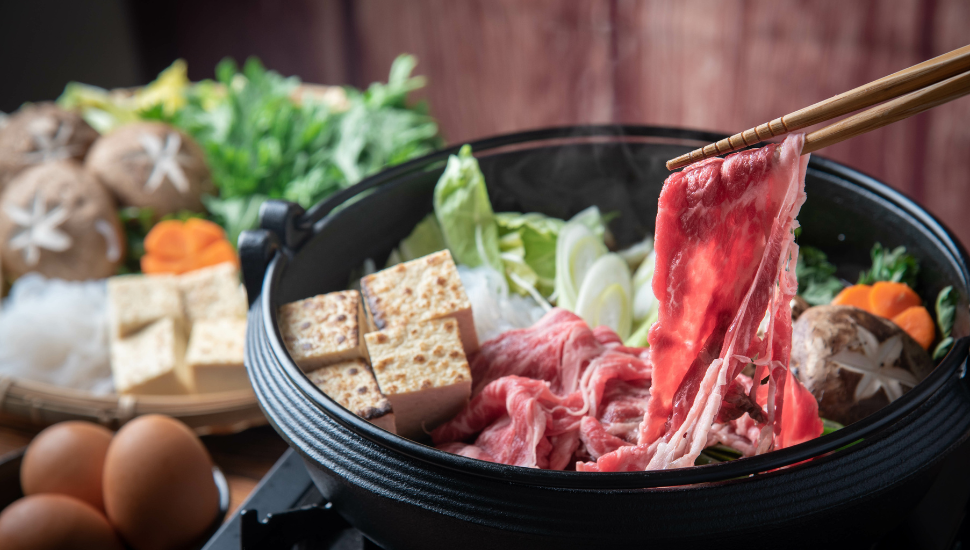A Taste of Japan: 8 Delicious Dining Experiences to Try
The Japanese take their food very seriously, with creativity and quality standards among the highest anywhere.
Indeed, no fewer than 30 Michelin 3-starred restaurants are found in Japan - which is impressive considering there are only 132 on the planet. Only France has as many.
It's no surprise then that any trip to Japan includes an ongoing culinary adventure, where food preparers are constantly looking for new ways to surprise and delight their diners.
If you don't want to fork out for a Japanese food guide book, we've put together a quick guide to help you navigate the scintillating food culture of Japan.
Washoku culture: food of Japan
"Washoku'' meaning "food of Japan'', underpins all of Japanese cuisine, and has been one of only two culinary traditions that has been recognised by UNESCO (as an Intangible Cultural Heritage of Humanity); the other is that of France.
Washoku is simultaneously simple and sophisticated, blending the five basic tastes: sweet, salty, sour, bitter, and umami.
Umami has risen to prominence in the West thanks largely to the popularity of Japanese cuisine - it's a savoury taste found in everything from fish sauces, soy sauces and broth, among many others.
And unlike other world cuisines, Japanese food does not rely heavily on spices. Instead, dishes coax out the natural flavours in the ingredients.
The importance of seasonality in Japanese cuisine
With four distinct seasons, a diverse range of vegetables and fruits are available at different times of the year.
When a certain type of produce reaches peak season (called shun), there's a celebratory aspect of dining, reflected in seasonal dishes and embraced by washoku.
Unlike some countries, recipes in Japan are constantly adapted to what produce is available.
Is eating out in Japan expensive?
While Japan consistently ranks in the top five most costly countries to live in, eating out here needn’t break the bank.
You can dine for as little as 1,000 yen (£6) per sitting, so 3,000 yen a day should suffice to keep you sustained on your trip.
What is Japanese food like?
With an emphasis on seasonal ingredients, Japanese cuisine is based around rice (like many other Asian nations, it's central to the cultural foods of Japan), miso soup, fish (sometimes served raw, as with sushi), grilled seafood and pickled vegetables.
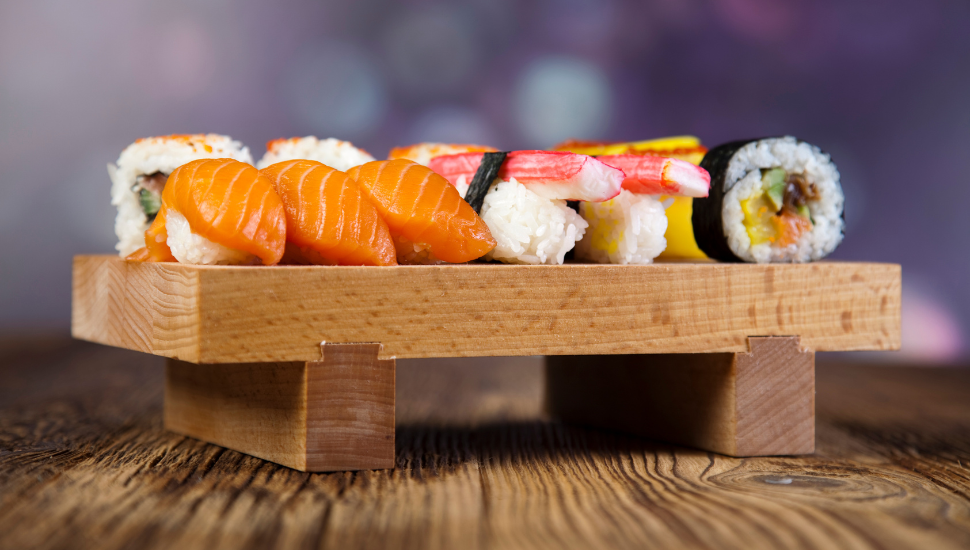
Sushi and sashimi
Given the range of Japanese cuisine available, in the west there is perhaps too much focus on sushi and sashimi - but these dishes are undeniably delicious and should certainly be sampled on your trip to Japan.
Kaiten Bars
Visit a kaiten bar for the quintessential sushi and sashimi experience.
Tiny bowls move around a bar on a conveyor belt and you simply choose the dish you want.
Because they are such small portions, you will almost certainly try a few of them, then pay for the dishes you’ve eaten when you leave.
If you want a specialty dish, you normally push the applicable button in front of you. This is then delivered (in the case of Uobei in Tokyo, by a tiny bullet train!).
Because the portions are small, you have the chance to try multiple dishes.
Why not sample sushi topped with cod roe? The sweetness of the fish contrasts with the saltiness of the roe.
Tuna sashimi is another must-try - with melt-in-your mouth fat marbled throughout the flesh.
Counter Sushi Restaurants
Ranked above the kaiten bar is the counter sushi restaurant, which allows you to see your meal being prepared.
These varieties vary in cost, with the Michelin-starred options at the top. Forking out for high-end dining is a wonderful experience, but the difference in quality will only be noticed by the true connoisseurs.
Most establishments offer a chef's menu, which includes around a dozen small dishes. This tasting menu is a great way to experience a broad range of dishes.
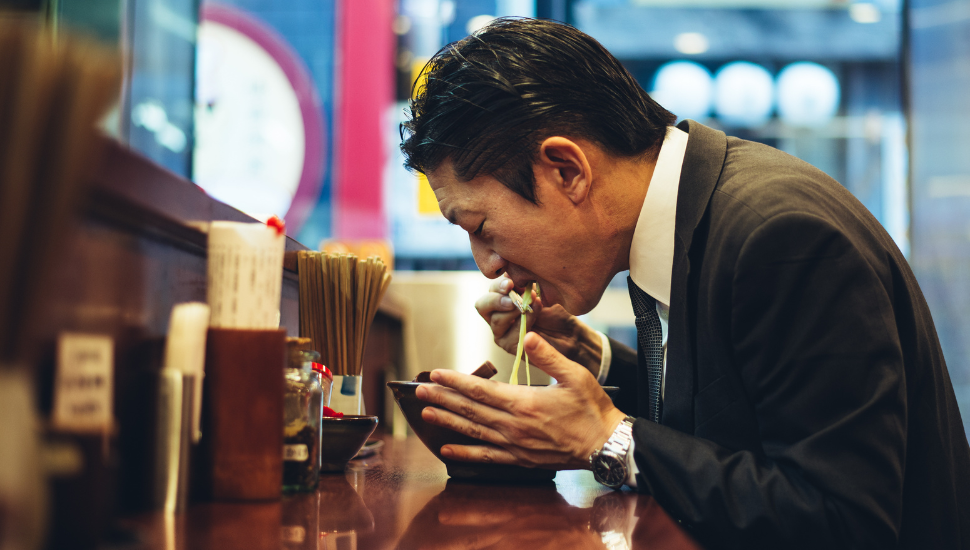
Ramen
You'll find noodle soup throughout Southeast and east Asia, but in Japan this simple dish comes in a dizzying array of varieties.
The Japanese themselves are near-obsessive about ramen culture, with TV shows regularly discussing different outlets and recipes.
Some regions even have mascots based on their particular ramen style. Ramen is undeniably a key cultural food of Japan.
Hokkaido's version of ramen is popular in winter and has a tonkotsu base (rich broth). The island also created the famous miso ramen - topped with butter and corn.
If you find yourself in Ramen Alley in Sapporo, make time to try some.
Wherever you are in Japan, small ramen shops are your best bet. These seat around six people and each has their own way of making ramen.
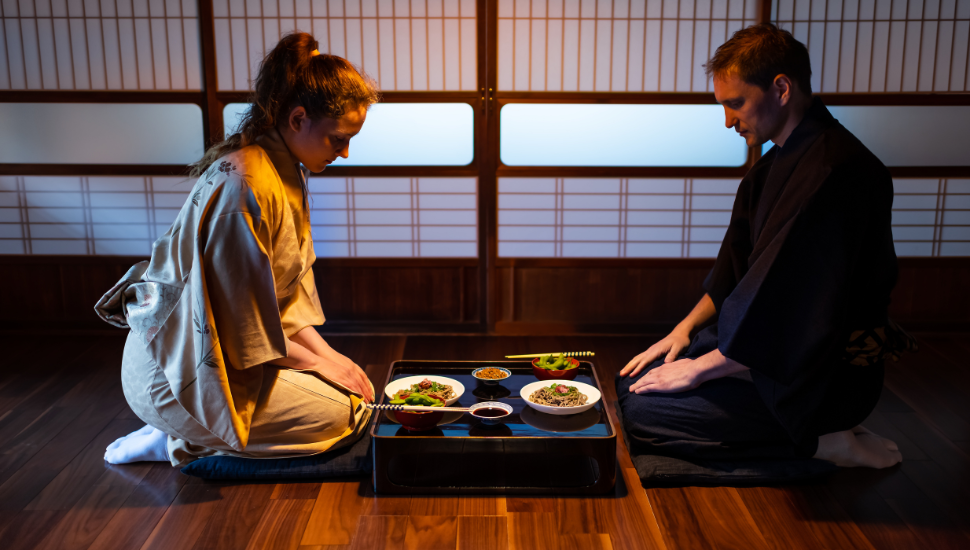
Kaiseki
This multi-course, multi-dish dining experience is comparable to a high-end tasting menu.
You'll normally be served kaiseki in traditional Japanese guest houses - called ryokan.
While some kaisekis are eaten with crossed legs, many guest houses have proper seating - so don't worry about getting sore legs.
Kaisei is something of a lucky dip; often informed by whatever the chef spots in the market that morning.
Even the most experienced Japanese cuisine aficionado may be surprised by what they're served. Indeed, often only by nibbling at a dish will you discover what's in it.
Local ingredients are key to kaiseki.
On Honshu's southern coast you might be served grilled eel; in Kanazawa, fresh crab; in Kobe, a steak - accompanied by all manner of other dishes.
Notably, kaiseki is a low-key, quiet dining experience.
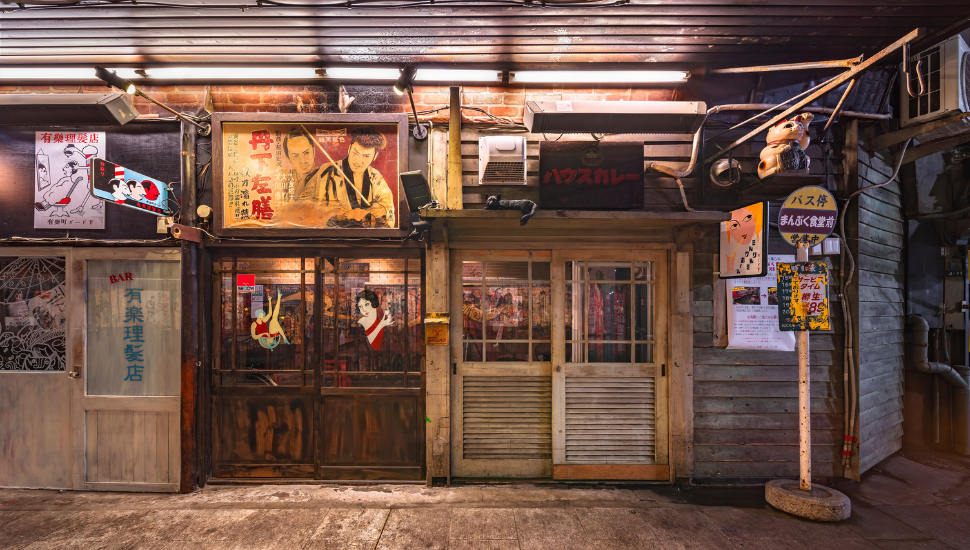
Credit: kuremo - stock.adobe.com
Japanese Izakaya Restaurants
Far more social - and affordable - izakaya restaurants are comparable to Spanish tapas bars or even gastro-pubs.
Izakaya restaurant menus are often vast, so they are great for those with specific dietary requirements (particularly vegetarians). They are also great when dining with children.
Izakayas are found across Japan, ranging from large brand-name establishments, to smaller places built into someone's home. The latter can look a little unkempt, but are often where you'll discover the most amazing dishes.
You simply enter your chosen izakaya, find a seat, then call a button for waiting staff. You can then select your desired meal by pointing at the pictures on the menu. Pick several dishes to share.
Look out for tebasaki - soy sauce-infused deep fried chicken wings, and karaage - cubes of chicken fried and marinated in ginger and garlic.
Japanese Street Food
Japanese street food differs dramatically from their Southeast Asian counterparts.
For one, eating while standing or walking is frowned upon in Japan, so you're always seated when sampling street food.
Most stalls have space for around four people. You watch your food being cooked, enjoy it, then move on to another street stall.
Like the price of Japanese street food stalls, the portions are small, so you'll have plenty of space for more culinary delights as you continue your dining odyssey.
In Tokyo, make a beeline for Memory Lane - a collection of about 50 street food stalls, each staffed by jolly cooks keen for you to sample their dishes.
Another street-food hotspot is the port city of Osaka, where okonomiyaki is ubiquitous.
Literally “whatever you like, cooked” okonomiyaki are thick savoury pancakes of mixed ingredients, often with pork belly and topped with mayonnaise.
Osaka is also famous for takoyaki, or “octopus balls”, which are pieces of octopus fried in balls of batter and served with dark, sweet takoyaki sauce, mayo and pickled ginger. However, takoyaki can be made from many other ingredients - not just octopus.
Sukiyaki
Hailing from Japan's rural areas, sukiyaki comprises slices of meat (usually beef) which is simmered at the table and combined with vegetables in a shallow iron pot of broth containing soy sauce, sugar, and mirin.
Sukiyaki is made in 'nabemono' (Japanese hot pot) style.
The dish was created by farmers who needed a dish that was simple to prepare.
It's a sweet, salty, hearty dish.
Given its countryside origins, you'll find the best sukiyaki in rural areas, although it is served everywhere from Hokaiddo to Tokyo to Kyushu.
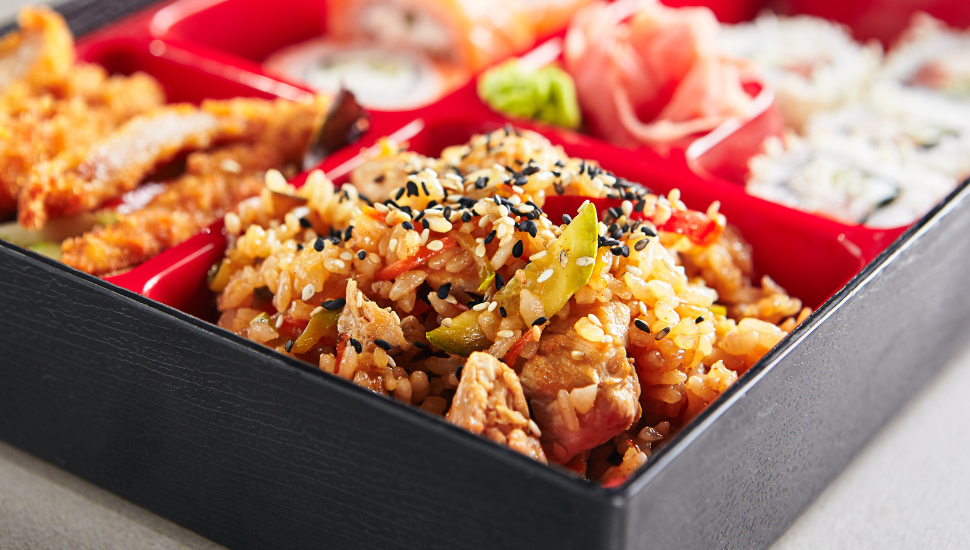
Bento
Bento is essentially a single-portion packed lunch, usually served in a plastic box with different compartments for the different bites.
Bento comes in many forms, but invariably features rice or noodles accompanied by items such as shumai (dumplings); spring rolls; fried gyoza; salad drizzled in ginger dressing; and types of tempura or teriyaki.
Bentos are considered a rather healthy option, since they often include pickled or cooked vegetables, and fruit.
Some of today's Japanese bentos take cues from Western cuisine, with sandwiches, salads and fried potatoes featured in the box.
While the word bento comes from a Chinese slang term meaning "convenient", and while they are certainly ideal for packed lunches under the cherry blossom or long journeys, they are actually often rather complex to make.
Never play with your food, the old adage goes - but no-one told the Japanese, since bentos are often fashioned into all sorts of images and icons.
Indeed, bentos must look as well as taste fabulous.
One modern version of bento - kyaraben - draws inspiration from cartoons, comic books and anime - and fashioning food to look like famous characters makes these bento boxes even trickier to prepare.
For instance, a ball of rice might be adorned with slices of seaweed to create eyes, whiskers and other details that lend personality to the item.
Oekakiben is another popular type of bento, fashioned into monuments, buildings and flowers, placing a certain image or mood in the mind of the diner before they begin eating.
Shikaeshiben is another - rather strange - type of bento.
This one gives the preparer the opportunity to shock or surprise the eater, since the shape and form of the food is fashioned into monsters and other unpalatable images. For example, sausages become severed fingers. It’s fitting then, that shikaeshi boxes are known as “spite bentos”!
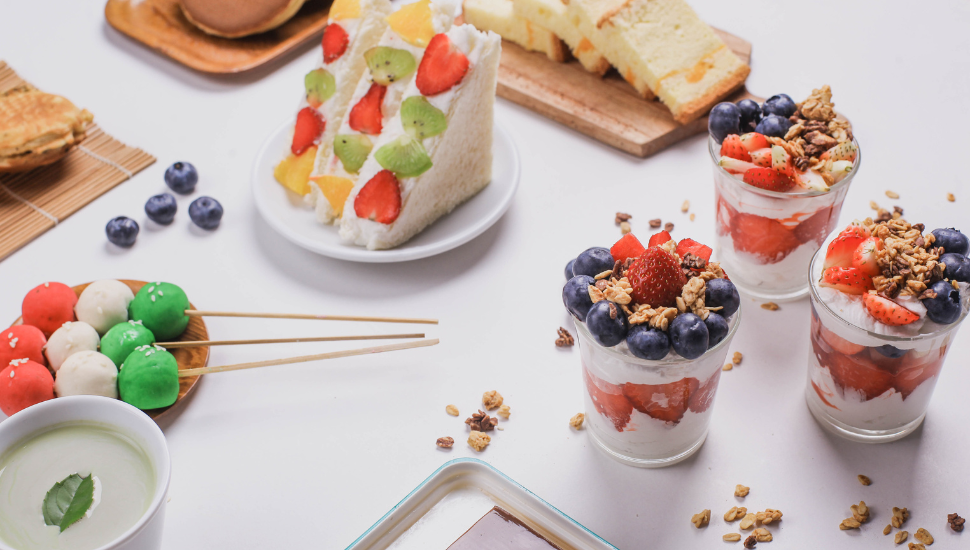
Japanese desserts
The term "wagashi" encompases Japanese desserts, some of which were created to accompany a particular drink.
Japanese desserts include pastries, baked goods and cakes.
Among the best known after-dinner treats are senbei and arare, which have been accompanying peoples' meals for more than 1,000 years.
These rice crackers are fashioned into all shapes, sizes and flavours. Most are sweet, but some are flavoured with soy sauce.
The difference between senbei and arare essentially comes down to shape, with arare looking like snow pellets, and senbei made to look more elaborate.
Arare are normally enjoyed during Hinamatsuri festival (Girls Day in Japan), and are created in a vast array of colours including pink, green, yellow and brown.
Coffee jelly is another popular dessert in Japan, prepared with sweetened coffee and agar-agar - a gelatinous substance made from red algae (so they're usually fine for vegetarians). They are served as straight-up drinks, or as ice cream floats and sundaes.
While mostly consumed in Japan, jelly coffee appears to have originated from 19th century Britain, with the first mention of the imbibe appearing in The New Family Receipt. The drink also became popular in America but has since fallen out of favour.
Daifuku, meanwhile, is a diminutive round of mochi (a glutinous rice cake) filled with azuki red beans or other ingredients. Daifuku is also made into ice cream.
Dorayaki is another popular treat, made famous by the anime series Doraemon, which features a character addicted to dorayaki.
These pancake-based sandwiches were inspired by a soft cake introduced to Japan by the Portuguese in the 16th century.
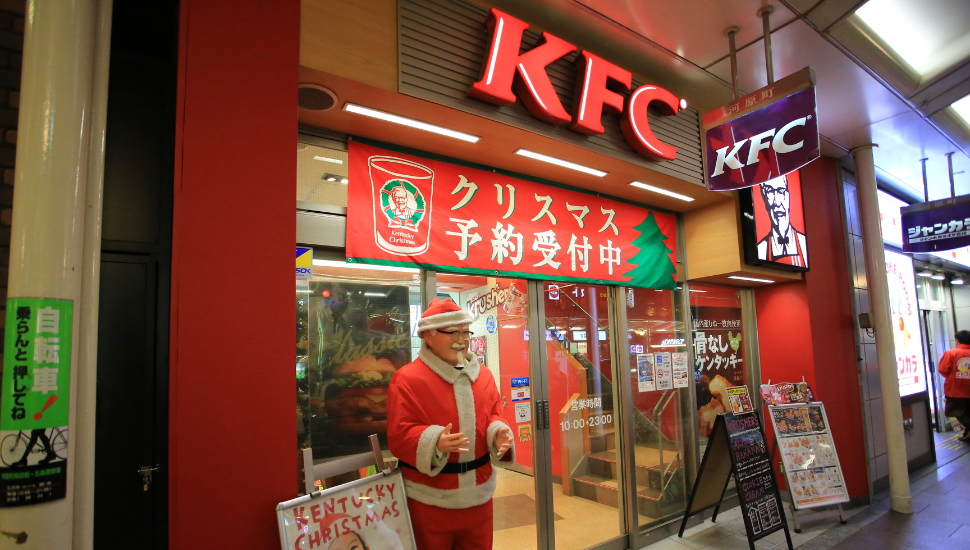
Credit: Lewis Tse Pui Lung - stock.adobe.com
Do Japanese eat fast food?
With more than 1,000 KFCs (the third-largest KFC market in the world), and nearly 3,000 McDonalds, it's safe to say fast food is part of Japanese food culture.
However, arguably Japan was eating fast food long before America embraced it.
The vast network of 7-Eleven outlets, for example, do a brisk business in hot, ready-to-eat buns, and onigiri rice balls.
More traditional fast foods include mochi and squid cooked on a hibachi and served on a skewer, alongside gyudon and curry rice. However, much of Japanese food is cooked and served "fast", often as quickly as a Big Mac or a Chicken Bucket!
Get a Quote